Comprehensive Analysis of OCBC Bank and Malaysian Banking
VerifiedAdded on 2021/09/18
|58
|16163
|123
Report
AI Summary
This report provides a comprehensive analysis of Oversea-Chinese Banking Corporation (OCBC) Bank, a major financial institution with a significant presence in Singapore and Malaysia. The analysis begins with an overview of the Malaysian banking industry, highlighting its performance and key trends, including loan growth and the impact of regulatory changes like MFRS 9. The report then delves into OCBC Bank's background, its categorization as both a depository and non-depository financial institution, and its classification as a consumer, business, investment, and Islamic bank. It explores the diverse services offered by OCBC, including consumer banking, business banking, investment banking, and transaction banking. Furthermore, the report examines OCBC Bank's balance sheet for the year 2016, detailing key assets and liabilities. Finally, the report briefly touches upon the bank's subsidiaries, services, and its role in the broader financial landscape. The report provides a detailed overview of the OCBC bank and financial system.
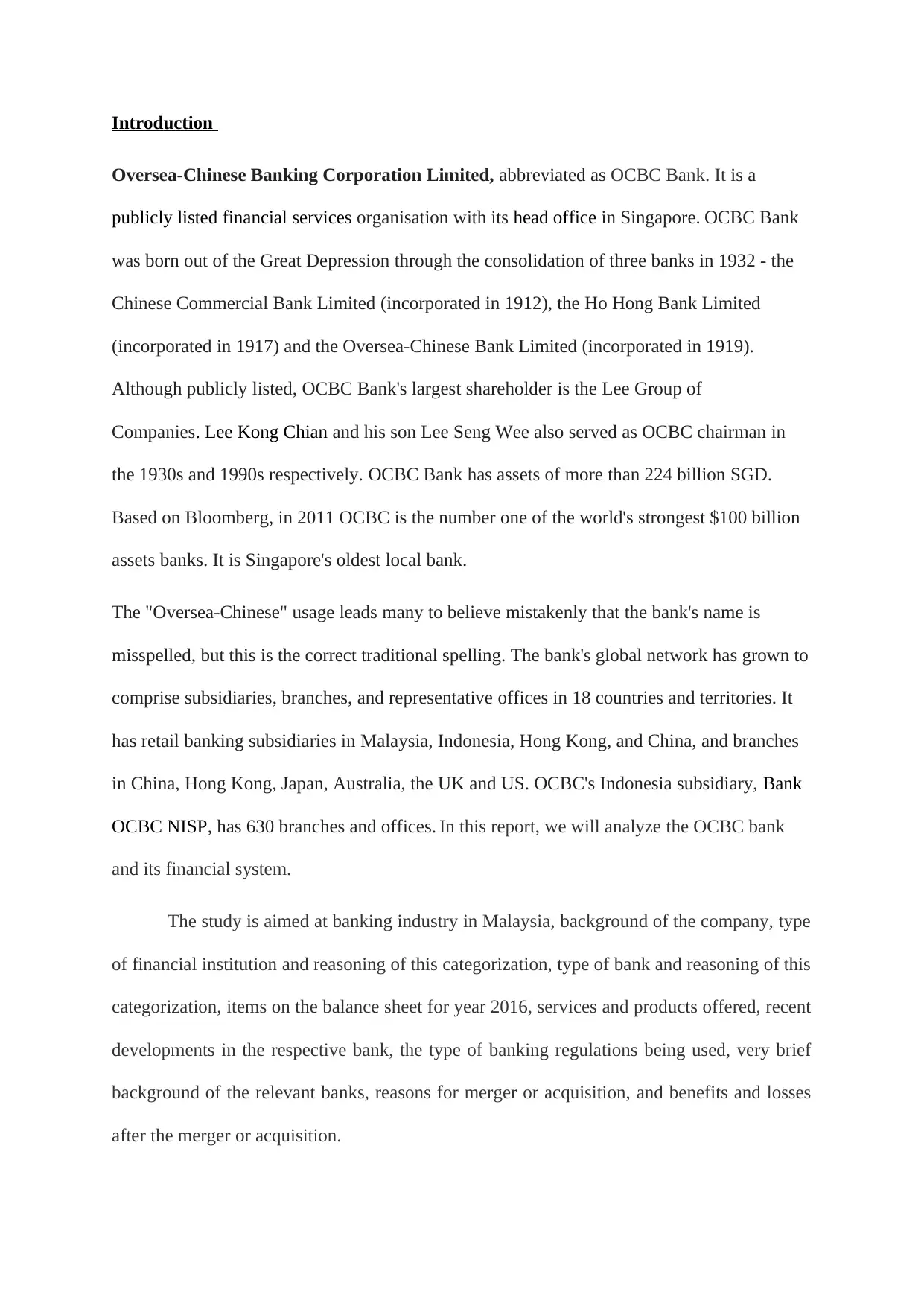
Introduction
Oversea-Chinese Banking Corporation Limited, abbreviated as OCBC Bank. It is a
publicly listed financial services organisation with its head office in Singapore. OCBC Bank
was born out of the Great Depression through the consolidation of three banks in 1932 - the
Chinese Commercial Bank Limited (incorporated in 1912), the Ho Hong Bank Limited
(incorporated in 1917) and the Oversea-Chinese Bank Limited (incorporated in 1919).
Although publicly listed, OCBC Bank's largest shareholder is the Lee Group of
Companies. Lee Kong Chian and his son Lee Seng Wee also served as OCBC chairman in
the 1930s and 1990s respectively. OCBC Bank has assets of more than 224 billion SGD.
Based on Bloomberg, in 2011 OCBC is the number one of the world's strongest $100 billion
assets banks. It is Singapore's oldest local bank.
The "Oversea-Chinese" usage leads many to believe mistakenly that the bank's name is
misspelled, but this is the correct traditional spelling. The bank's global network has grown to
comprise subsidiaries, branches, and representative offices in 18 countries and territories. It
has retail banking subsidiaries in Malaysia, Indonesia, Hong Kong, and China, and branches
in China, Hong Kong, Japan, Australia, the UK and US. OCBC's Indonesia subsidiary, Bank
OCBC NISP, has 630 branches and offices. In this report, we will analyze the OCBC bank
and its financial system.
The study is aimed at banking industry in Malaysia, background of the company, type
of financial institution and reasoning of this categorization, type of bank and reasoning of this
categorization, items on the balance sheet for year 2016, services and products offered, recent
developments in the respective bank, the type of banking regulations being used, very brief
background of the relevant banks, reasons for merger or acquisition, and benefits and losses
after the merger or acquisition.
Oversea-Chinese Banking Corporation Limited, abbreviated as OCBC Bank. It is a
publicly listed financial services organisation with its head office in Singapore. OCBC Bank
was born out of the Great Depression through the consolidation of three banks in 1932 - the
Chinese Commercial Bank Limited (incorporated in 1912), the Ho Hong Bank Limited
(incorporated in 1917) and the Oversea-Chinese Bank Limited (incorporated in 1919).
Although publicly listed, OCBC Bank's largest shareholder is the Lee Group of
Companies. Lee Kong Chian and his son Lee Seng Wee also served as OCBC chairman in
the 1930s and 1990s respectively. OCBC Bank has assets of more than 224 billion SGD.
Based on Bloomberg, in 2011 OCBC is the number one of the world's strongest $100 billion
assets banks. It is Singapore's oldest local bank.
The "Oversea-Chinese" usage leads many to believe mistakenly that the bank's name is
misspelled, but this is the correct traditional spelling. The bank's global network has grown to
comprise subsidiaries, branches, and representative offices in 18 countries and territories. It
has retail banking subsidiaries in Malaysia, Indonesia, Hong Kong, and China, and branches
in China, Hong Kong, Japan, Australia, the UK and US. OCBC's Indonesia subsidiary, Bank
OCBC NISP, has 630 branches and offices. In this report, we will analyze the OCBC bank
and its financial system.
The study is aimed at banking industry in Malaysia, background of the company, type
of financial institution and reasoning of this categorization, type of bank and reasoning of this
categorization, items on the balance sheet for year 2016, services and products offered, recent
developments in the respective bank, the type of banking regulations being used, very brief
background of the relevant banks, reasons for merger or acquisition, and benefits and losses
after the merger or acquisition.
Paraphrase This Document
Need a fresh take? Get an instant paraphrase of this document with our AI Paraphraser

Banking industry in Malaysia
In the research for year 2018, on average, the share price of the local banking players
surged about 17%, with the two banking giants – Malayan Banking Berhad and CIMB Group
Holdings Berhad rising close to 24% and 51% respectively. As the banking industry accounts
for about 32% of weightage in FBMKLCI Index, the sector’s prospect would provide
harbinger of the performance for FBMKLCI Index.
PERFORMANCE OF BANKING SECTOR
Banks' Net Profit Growth
HEALTHY LOAN GROWTH
In the research for year 2018, on average, the share price of the local banking players
surged about 17%, with the two banking giants – Malayan Banking Berhad and CIMB Group
Holdings Berhad rising close to 24% and 51% respectively. As the banking industry accounts
for about 32% of weightage in FBMKLCI Index, the sector’s prospect would provide
harbinger of the performance for FBMKLCI Index.
PERFORMANCE OF BANKING SECTOR
Banks' Net Profit Growth
HEALTHY LOAN GROWTH
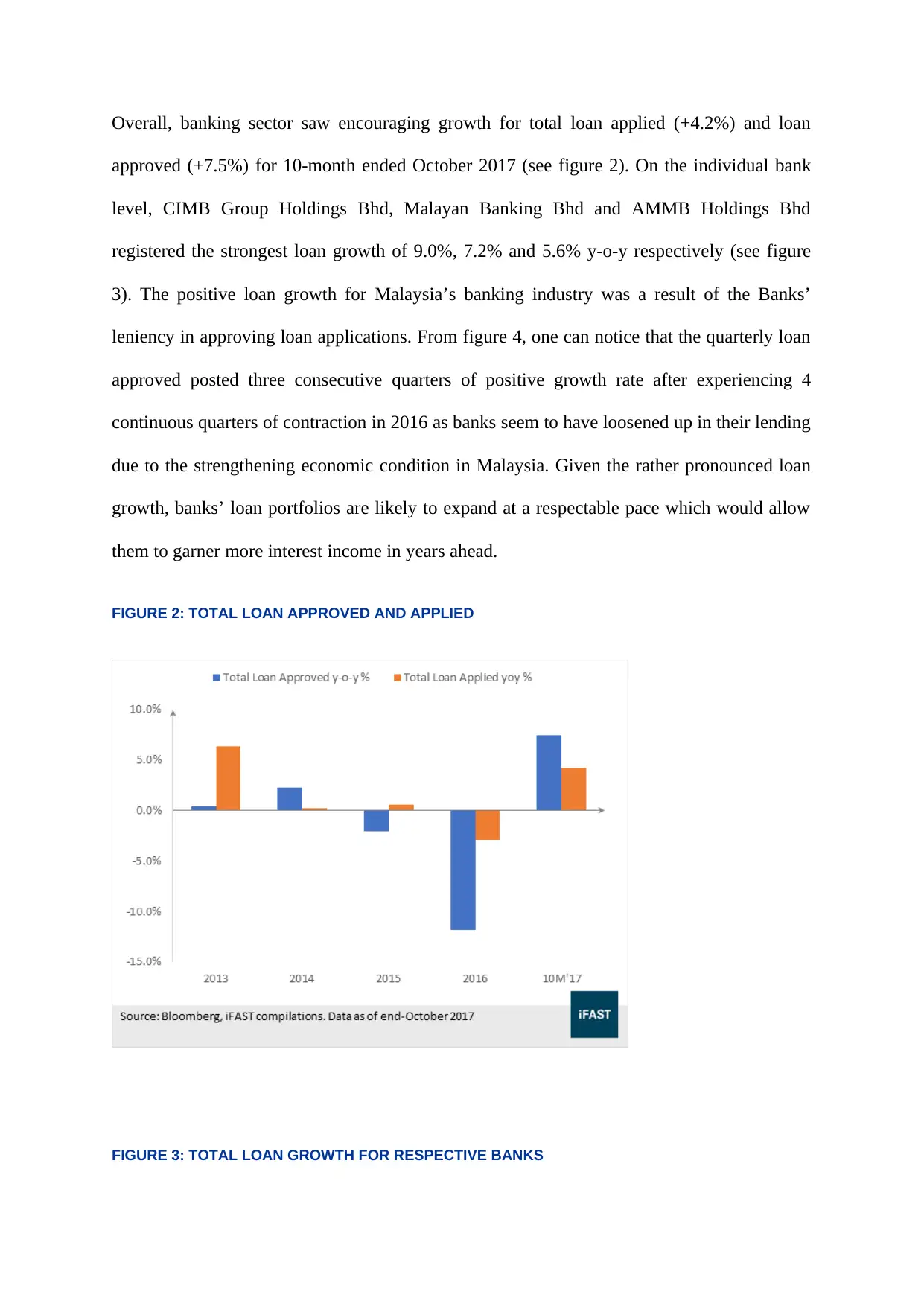
Overall, banking sector saw encouraging growth for total loan applied (+4.2%) and loan
approved (+7.5%) for 10-month ended October 2017 (see figure 2). On the individual bank
level, CIMB Group Holdings Bhd, Malayan Banking Bhd and AMMB Holdings Bhd
registered the strongest loan growth of 9.0%, 7.2% and 5.6% y-o-y respectively (see figure
3). The positive loan growth for Malaysia’s banking industry was a result of the Banks’
leniency in approving loan applications. From figure 4, one can notice that the quarterly loan
approved posted three consecutive quarters of positive growth rate after experiencing 4
continuous quarters of contraction in 2016 as banks seem to have loosened up in their lending
due to the strengthening economic condition in Malaysia. Given the rather pronounced loan
growth, banks’ loan portfolios are likely to expand at a respectable pace which would allow
them to garner more interest income in years ahead.
FIGURE 2: TOTAL LOAN APPROVED AND APPLIED
FIGURE 3: TOTAL LOAN GROWTH FOR RESPECTIVE BANKS
approved (+7.5%) for 10-month ended October 2017 (see figure 2). On the individual bank
level, CIMB Group Holdings Bhd, Malayan Banking Bhd and AMMB Holdings Bhd
registered the strongest loan growth of 9.0%, 7.2% and 5.6% y-o-y respectively (see figure
3). The positive loan growth for Malaysia’s banking industry was a result of the Banks’
leniency in approving loan applications. From figure 4, one can notice that the quarterly loan
approved posted three consecutive quarters of positive growth rate after experiencing 4
continuous quarters of contraction in 2016 as banks seem to have loosened up in their lending
due to the strengthening economic condition in Malaysia. Given the rather pronounced loan
growth, banks’ loan portfolios are likely to expand at a respectable pace which would allow
them to garner more interest income in years ahead.
FIGURE 2: TOTAL LOAN APPROVED AND APPLIED
FIGURE 3: TOTAL LOAN GROWTH FOR RESPECTIVE BANKS
⊘ This is a preview!⊘
Do you want full access?
Subscribe today to unlock all pages.

Trusted by 1+ million students worldwide
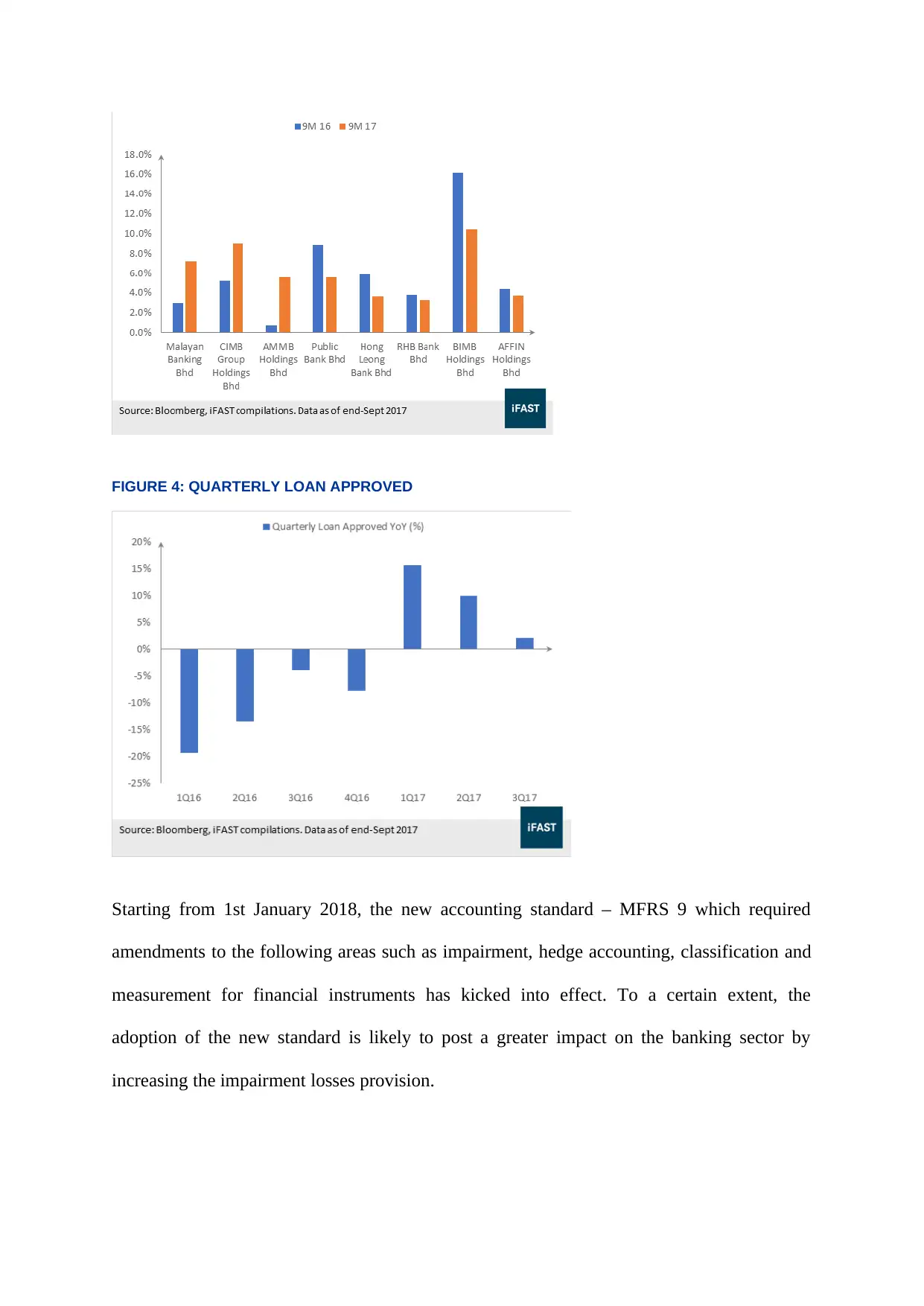
FIGURE 4: QUARTERLY LOAN APPROVED
Starting from 1st January 2018, the new accounting standard – MFRS 9 which required
amendments to the following areas such as impairment, hedge accounting, classification and
measurement for financial instruments has kicked into effect. To a certain extent, the
adoption of the new standard is likely to post a greater impact on the banking sector by
increasing the impairment losses provision.
Starting from 1st January 2018, the new accounting standard – MFRS 9 which required
amendments to the following areas such as impairment, hedge accounting, classification and
measurement for financial instruments has kicked into effect. To a certain extent, the
adoption of the new standard is likely to post a greater impact on the banking sector by
increasing the impairment losses provision.
Paraphrase This Document
Need a fresh take? Get an instant paraphrase of this document with our AI Paraphraser
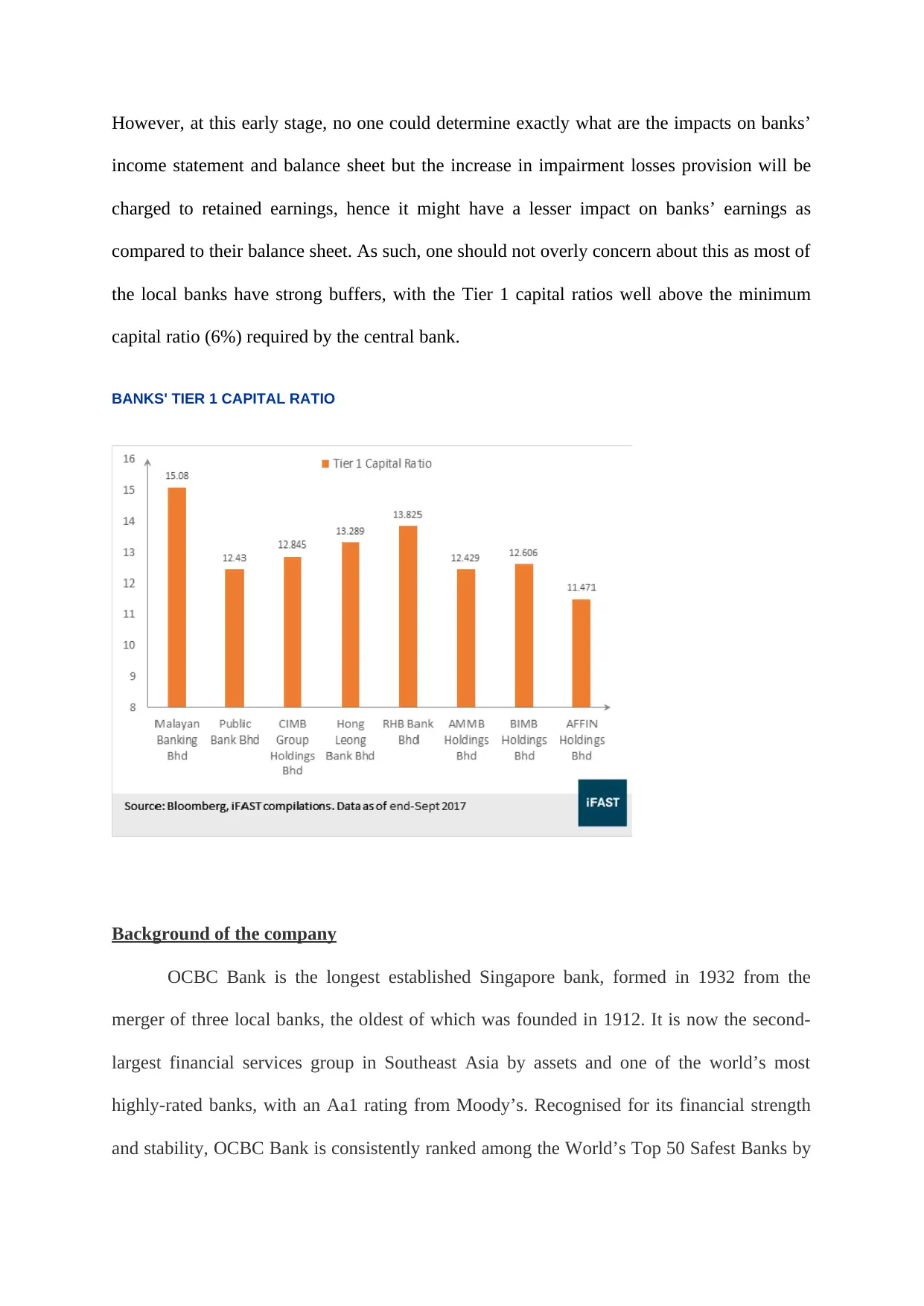
However, at this early stage, no one could determine exactly what are the impacts on banks’
income statement and balance sheet but the increase in impairment losses provision will be
charged to retained earnings, hence it might have a lesser impact on banks’ earnings as
compared to their balance sheet. As such, one should not overly concern about this as most of
the local banks have strong buffers, with the Tier 1 capital ratios well above the minimum
capital ratio (6%) required by the central bank.
BANKS' TIER 1 CAPITAL RATIO
Background of the company
OCBC Bank is the longest established Singapore bank, formed in 1932 from the
merger of three local banks, the oldest of which was founded in 1912. It is now the second-
largest financial services group in Southeast Asia by assets and one of the world’s most
highly-rated banks, with an Aa1 rating from Moody’s. Recognised for its financial strength
and stability, OCBC Bank is consistently ranked among the World’s Top 50 Safest Banks by
income statement and balance sheet but the increase in impairment losses provision will be
charged to retained earnings, hence it might have a lesser impact on banks’ earnings as
compared to their balance sheet. As such, one should not overly concern about this as most of
the local banks have strong buffers, with the Tier 1 capital ratios well above the minimum
capital ratio (6%) required by the central bank.
BANKS' TIER 1 CAPITAL RATIO
Background of the company
OCBC Bank is the longest established Singapore bank, formed in 1932 from the
merger of three local banks, the oldest of which was founded in 1912. It is now the second-
largest financial services group in Southeast Asia by assets and one of the world’s most
highly-rated banks, with an Aa1 rating from Moody’s. Recognised for its financial strength
and stability, OCBC Bank is consistently ranked among the World’s Top 50 Safest Banks by
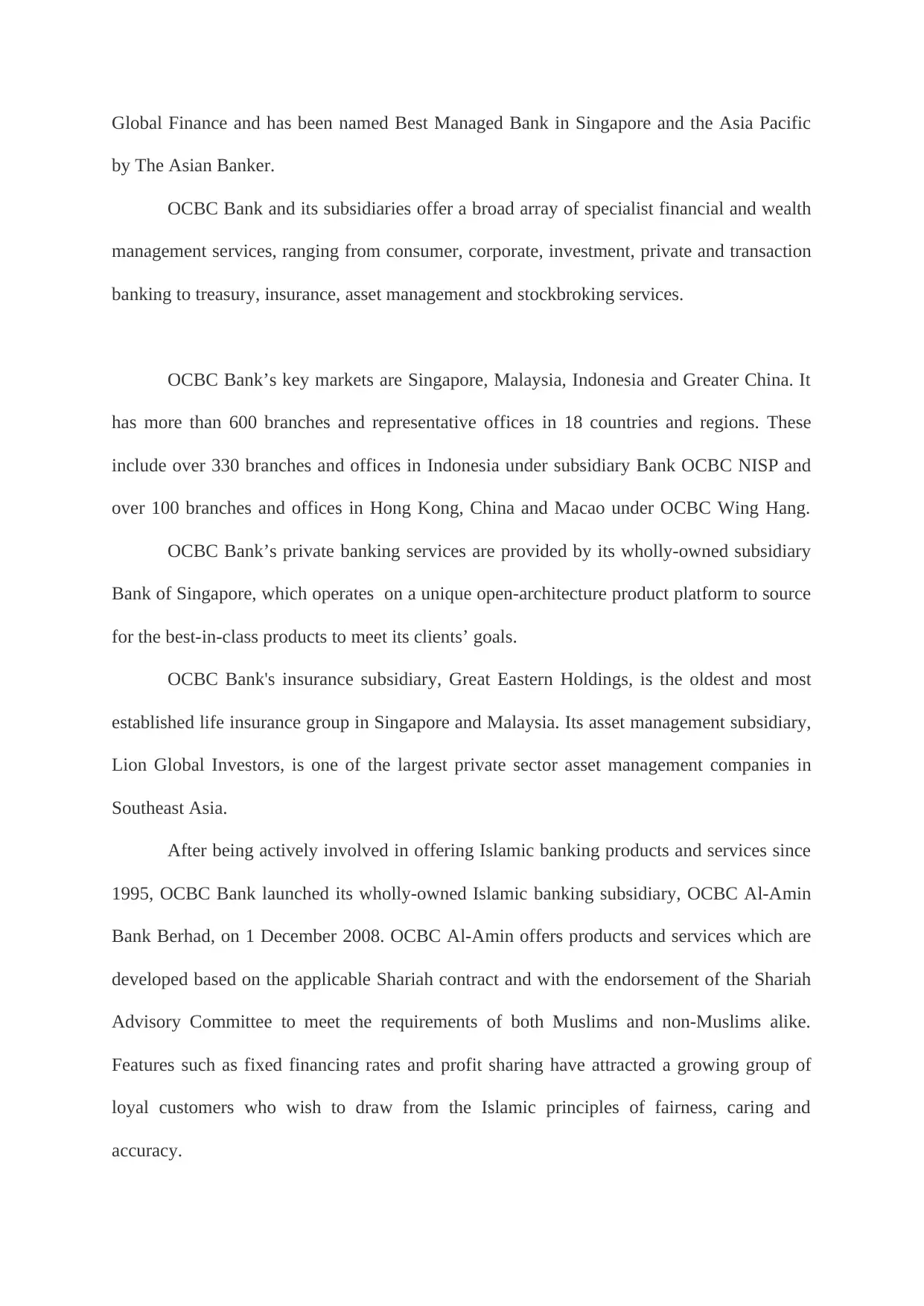
Global Finance and has been named Best Managed Bank in Singapore and the Asia Pacific
by The Asian Banker.
OCBC Bank and its subsidiaries offer a broad array of specialist financial and wealth
management services, ranging from consumer, corporate, investment, private and transaction
banking to treasury, insurance, asset management and stockbroking services.
OCBC Bank’s key markets are Singapore, Malaysia, Indonesia and Greater China. It
has more than 600 branches and representative offices in 18 countries and regions. These
include over 330 branches and offices in Indonesia under subsidiary Bank OCBC NISP and
over 100 branches and offices in Hong Kong, China and Macao under OCBC Wing Hang.
OCBC Bank’s private banking services are provided by its wholly-owned subsidiary
Bank of Singapore, which operates on a unique open-architecture product platform to source
for the best-in-class products to meet its clients’ goals.
OCBC Bank's insurance subsidiary, Great Eastern Holdings, is the oldest and most
established life insurance group in Singapore and Malaysia. Its asset management subsidiary,
Lion Global Investors, is one of the largest private sector asset management companies in
Southeast Asia.
After being actively involved in offering Islamic banking products and services since
1995, OCBC Bank launched its wholly-owned Islamic banking subsidiary, OCBC Al-Amin
Bank Berhad, on 1 December 2008. OCBC Al-Amin offers products and services which are
developed based on the applicable Shariah contract and with the endorsement of the Shariah
Advisory Committee to meet the requirements of both Muslims and non-Muslims alike.
Features such as fixed financing rates and profit sharing have attracted a growing group of
loyal customers who wish to draw from the Islamic principles of fairness, caring and
accuracy.
by The Asian Banker.
OCBC Bank and its subsidiaries offer a broad array of specialist financial and wealth
management services, ranging from consumer, corporate, investment, private and transaction
banking to treasury, insurance, asset management and stockbroking services.
OCBC Bank’s key markets are Singapore, Malaysia, Indonesia and Greater China. It
has more than 600 branches and representative offices in 18 countries and regions. These
include over 330 branches and offices in Indonesia under subsidiary Bank OCBC NISP and
over 100 branches and offices in Hong Kong, China and Macao under OCBC Wing Hang.
OCBC Bank’s private banking services are provided by its wholly-owned subsidiary
Bank of Singapore, which operates on a unique open-architecture product platform to source
for the best-in-class products to meet its clients’ goals.
OCBC Bank's insurance subsidiary, Great Eastern Holdings, is the oldest and most
established life insurance group in Singapore and Malaysia. Its asset management subsidiary,
Lion Global Investors, is one of the largest private sector asset management companies in
Southeast Asia.
After being actively involved in offering Islamic banking products and services since
1995, OCBC Bank launched its wholly-owned Islamic banking subsidiary, OCBC Al-Amin
Bank Berhad, on 1 December 2008. OCBC Al-Amin offers products and services which are
developed based on the applicable Shariah contract and with the endorsement of the Shariah
Advisory Committee to meet the requirements of both Muslims and non-Muslims alike.
Features such as fixed financing rates and profit sharing have attracted a growing group of
loyal customers who wish to draw from the Islamic principles of fairness, caring and
accuracy.
⊘ This is a preview!⊘
Do you want full access?
Subscribe today to unlock all pages.

Trusted by 1+ million students worldwide
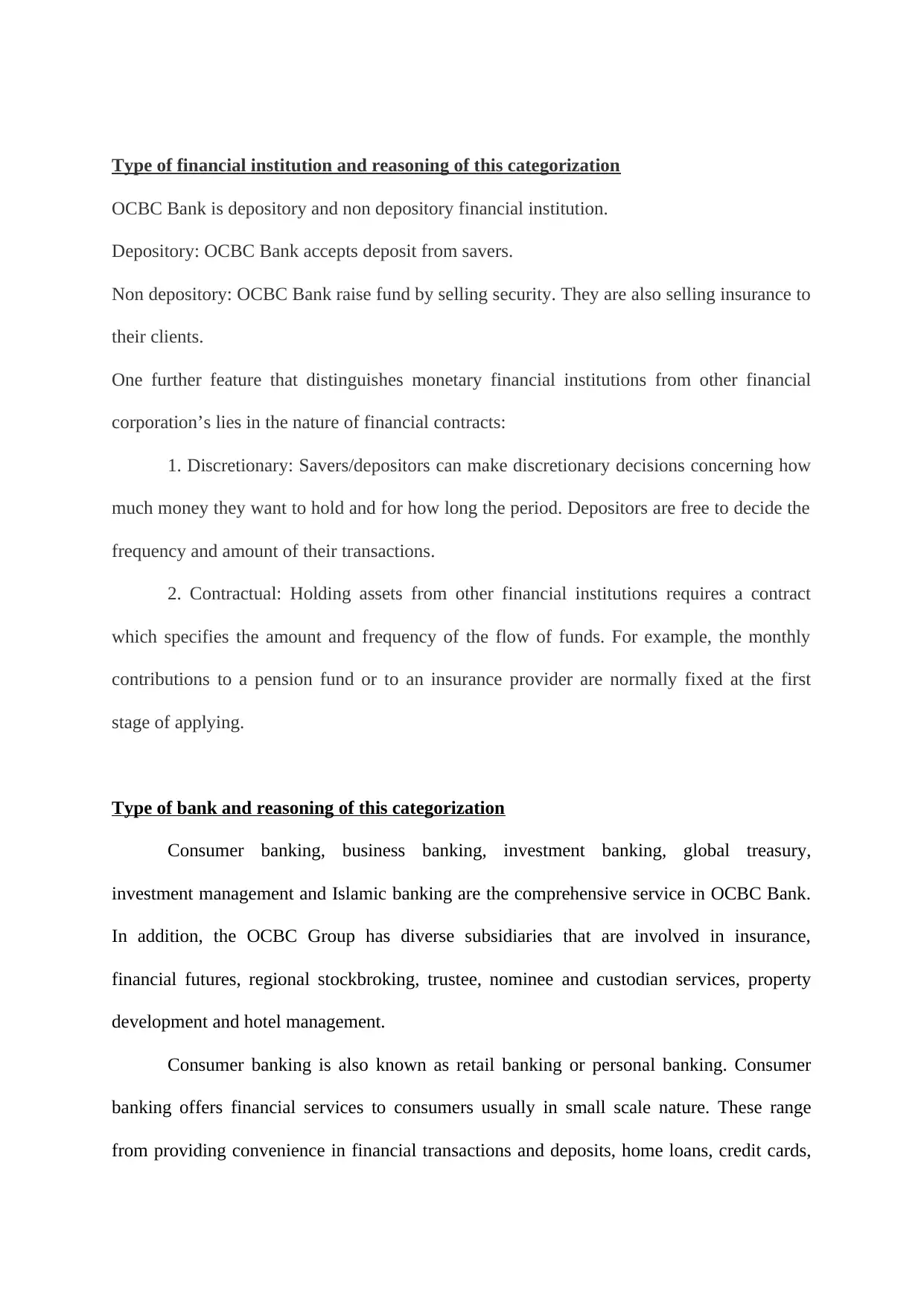
Type of financial institution and reasoning of this categorization
OCBC Bank is depository and non depository financial institution.
Depository: OCBC Bank accepts deposit from savers.
Non depository: OCBC Bank raise fund by selling security. They are also selling insurance to
their clients.
One further feature that distinguishes monetary financial institutions from other financial
corporation’s lies in the nature of financial contracts:
1. Discretionary: Savers/depositors can make discretionary decisions concerning how
much money they want to hold and for how long the period. Depositors are free to decide the
frequency and amount of their transactions.
2. Contractual: Holding assets from other financial institutions requires a contract
which specifies the amount and frequency of the flow of funds. For example, the monthly
contributions to a pension fund or to an insurance provider are normally fixed at the first
stage of applying.
Type of bank and reasoning of this categorization
Consumer banking, business banking, investment banking, global treasury,
investment management and Islamic banking are the comprehensive service in OCBC Bank.
In addition, the OCBC Group has diverse subsidiaries that are involved in insurance,
financial futures, regional stockbroking, trustee, nominee and custodian services, property
development and hotel management.
Consumer banking is also known as retail banking or personal banking. Consumer
banking offers financial services to consumers usually in small scale nature. These range
from providing convenience in financial transactions and deposits, home loans, credit cards,
OCBC Bank is depository and non depository financial institution.
Depository: OCBC Bank accepts deposit from savers.
Non depository: OCBC Bank raise fund by selling security. They are also selling insurance to
their clients.
One further feature that distinguishes monetary financial institutions from other financial
corporation’s lies in the nature of financial contracts:
1. Discretionary: Savers/depositors can make discretionary decisions concerning how
much money they want to hold and for how long the period. Depositors are free to decide the
frequency and amount of their transactions.
2. Contractual: Holding assets from other financial institutions requires a contract
which specifies the amount and frequency of the flow of funds. For example, the monthly
contributions to a pension fund or to an insurance provider are normally fixed at the first
stage of applying.
Type of bank and reasoning of this categorization
Consumer banking, business banking, investment banking, global treasury,
investment management and Islamic banking are the comprehensive service in OCBC Bank.
In addition, the OCBC Group has diverse subsidiaries that are involved in insurance,
financial futures, regional stockbroking, trustee, nominee and custodian services, property
development and hotel management.
Consumer banking is also known as retail banking or personal banking. Consumer
banking offers financial services to consumers usually in small scale nature. These range
from providing convenience in financial transactions and deposits, home loans, credit cards,
Paraphrase This Document
Need a fresh take? Get an instant paraphrase of this document with our AI Paraphraser
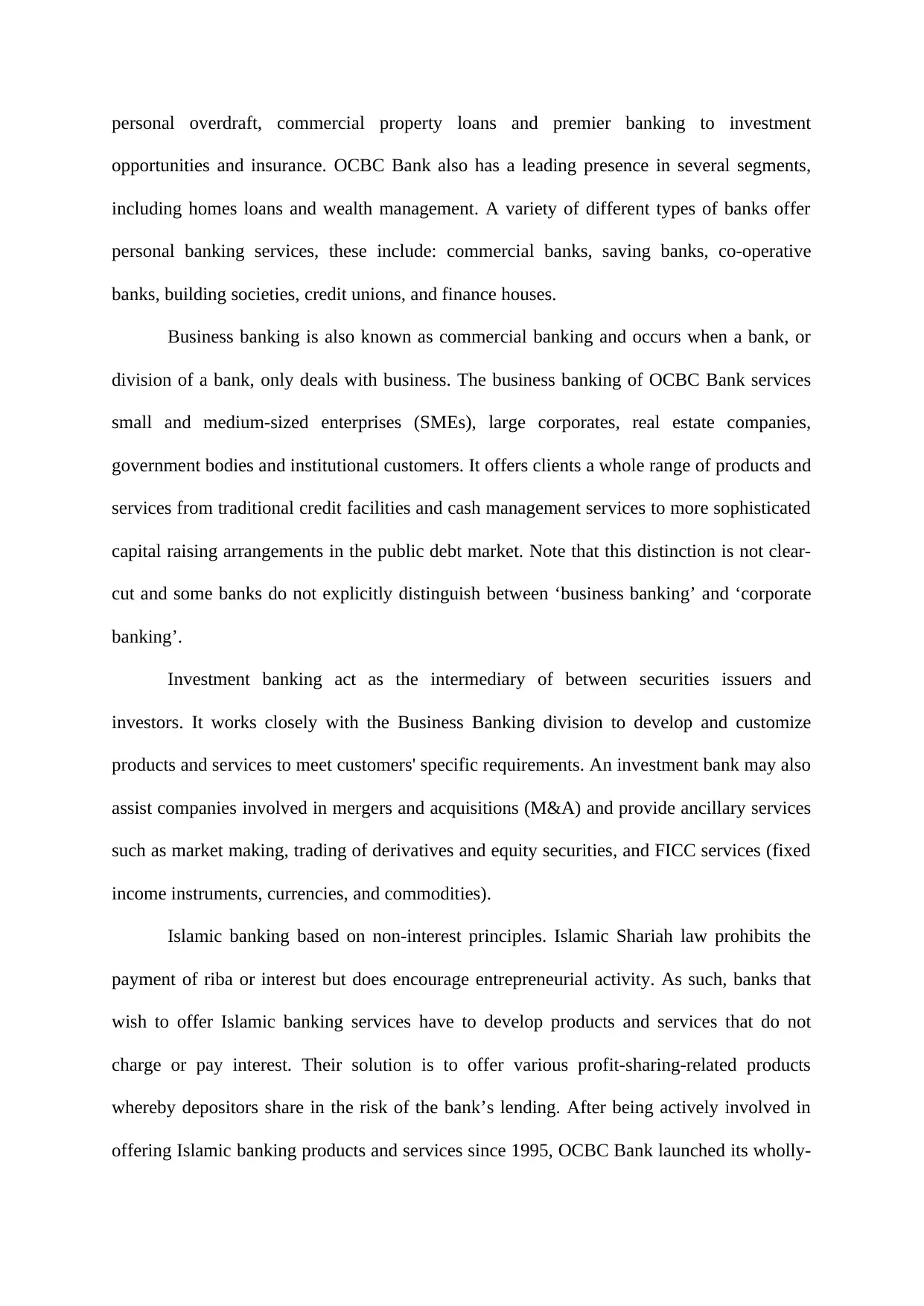
personal overdraft, commercial property loans and premier banking to investment
opportunities and insurance. OCBC Bank also has a leading presence in several segments,
including homes loans and wealth management. A variety of different types of banks offer
personal banking services, these include: commercial banks, saving banks, co-operative
banks, building societies, credit unions, and finance houses.
Business banking is also known as commercial banking and occurs when a bank, or
division of a bank, only deals with business. The business banking of OCBC Bank services
small and medium-sized enterprises (SMEs), large corporates, real estate companies,
government bodies and institutional customers. It offers clients a whole range of products and
services from traditional credit facilities and cash management services to more sophisticated
capital raising arrangements in the public debt market. Note that this distinction is not clear-
cut and some banks do not explicitly distinguish between ‘business banking’ and ‘corporate
banking’.
Investment banking act as the intermediary of between securities issuers and
investors. It works closely with the Business Banking division to develop and customize
products and services to meet customers' specific requirements. An investment bank may also
assist companies involved in mergers and acquisitions (M&A) and provide ancillary services
such as market making, trading of derivatives and equity securities, and FICC services (fixed
income instruments, currencies, and commodities).
Islamic banking based on non-interest principles. Islamic Shariah law prohibits the
payment of riba or interest but does encourage entrepreneurial activity. As such, banks that
wish to offer Islamic banking services have to develop products and services that do not
charge or pay interest. Their solution is to offer various profit-sharing-related products
whereby depositors share in the risk of the bank’s lending. After being actively involved in
offering Islamic banking products and services since 1995, OCBC Bank launched its wholly-
opportunities and insurance. OCBC Bank also has a leading presence in several segments,
including homes loans and wealth management. A variety of different types of banks offer
personal banking services, these include: commercial banks, saving banks, co-operative
banks, building societies, credit unions, and finance houses.
Business banking is also known as commercial banking and occurs when a bank, or
division of a bank, only deals with business. The business banking of OCBC Bank services
small and medium-sized enterprises (SMEs), large corporates, real estate companies,
government bodies and institutional customers. It offers clients a whole range of products and
services from traditional credit facilities and cash management services to more sophisticated
capital raising arrangements in the public debt market. Note that this distinction is not clear-
cut and some banks do not explicitly distinguish between ‘business banking’ and ‘corporate
banking’.
Investment banking act as the intermediary of between securities issuers and
investors. It works closely with the Business Banking division to develop and customize
products and services to meet customers' specific requirements. An investment bank may also
assist companies involved in mergers and acquisitions (M&A) and provide ancillary services
such as market making, trading of derivatives and equity securities, and FICC services (fixed
income instruments, currencies, and commodities).
Islamic banking based on non-interest principles. Islamic Shariah law prohibits the
payment of riba or interest but does encourage entrepreneurial activity. As such, banks that
wish to offer Islamic banking services have to develop products and services that do not
charge or pay interest. Their solution is to offer various profit-sharing-related products
whereby depositors share in the risk of the bank’s lending. After being actively involved in
offering Islamic banking products and services since 1995, OCBC Bank launched its wholly-
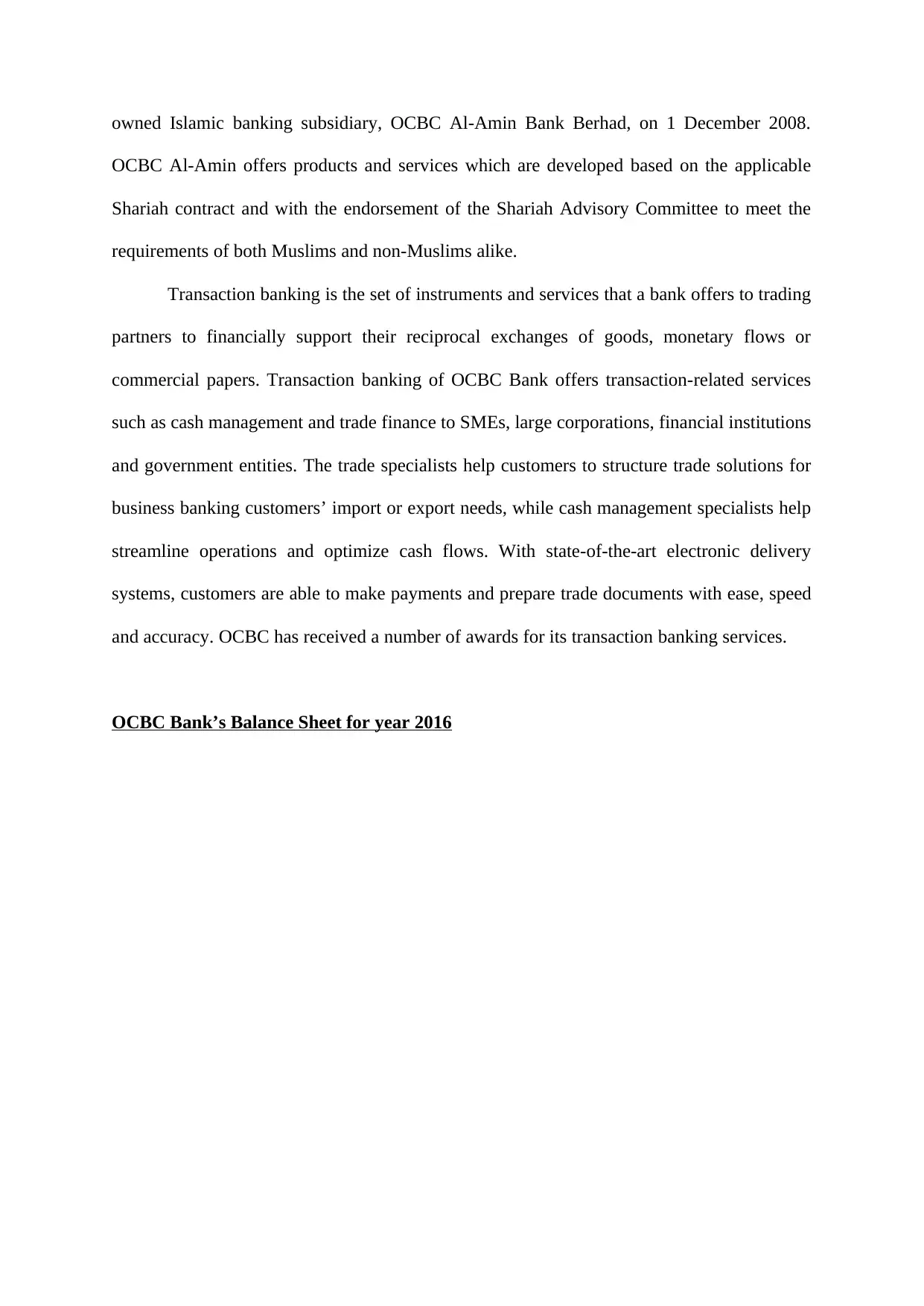
owned Islamic banking subsidiary, OCBC Al-Amin Bank Berhad, on 1 December 2008.
OCBC Al-Amin offers products and services which are developed based on the applicable
Shariah contract and with the endorsement of the Shariah Advisory Committee to meet the
requirements of both Muslims and non-Muslims alike.
Transaction banking is the set of instruments and services that a bank offers to trading
partners to financially support their reciprocal exchanges of goods, monetary flows or
commercial papers. Transaction banking of OCBC Bank offers transaction-related services
such as cash management and trade finance to SMEs, large corporations, financial institutions
and government entities. The trade specialists help customers to structure trade solutions for
business banking customers’ import or export needs, while cash management specialists help
streamline operations and optimize cash flows. With state-of-the-art electronic delivery
systems, customers are able to make payments and prepare trade documents with ease, speed
and accuracy. OCBC has received a number of awards for its transaction banking services.
OCBC Bank’s Balance Sheet for year 2016
OCBC Al-Amin offers products and services which are developed based on the applicable
Shariah contract and with the endorsement of the Shariah Advisory Committee to meet the
requirements of both Muslims and non-Muslims alike.
Transaction banking is the set of instruments and services that a bank offers to trading
partners to financially support their reciprocal exchanges of goods, monetary flows or
commercial papers. Transaction banking of OCBC Bank offers transaction-related services
such as cash management and trade finance to SMEs, large corporations, financial institutions
and government entities. The trade specialists help customers to structure trade solutions for
business banking customers’ import or export needs, while cash management specialists help
streamline operations and optimize cash flows. With state-of-the-art electronic delivery
systems, customers are able to make payments and prepare trade documents with ease, speed
and accuracy. OCBC has received a number of awards for its transaction banking services.
OCBC Bank’s Balance Sheet for year 2016
⊘ This is a preview!⊘
Do you want full access?
Subscribe today to unlock all pages.

Trusted by 1+ million students worldwide
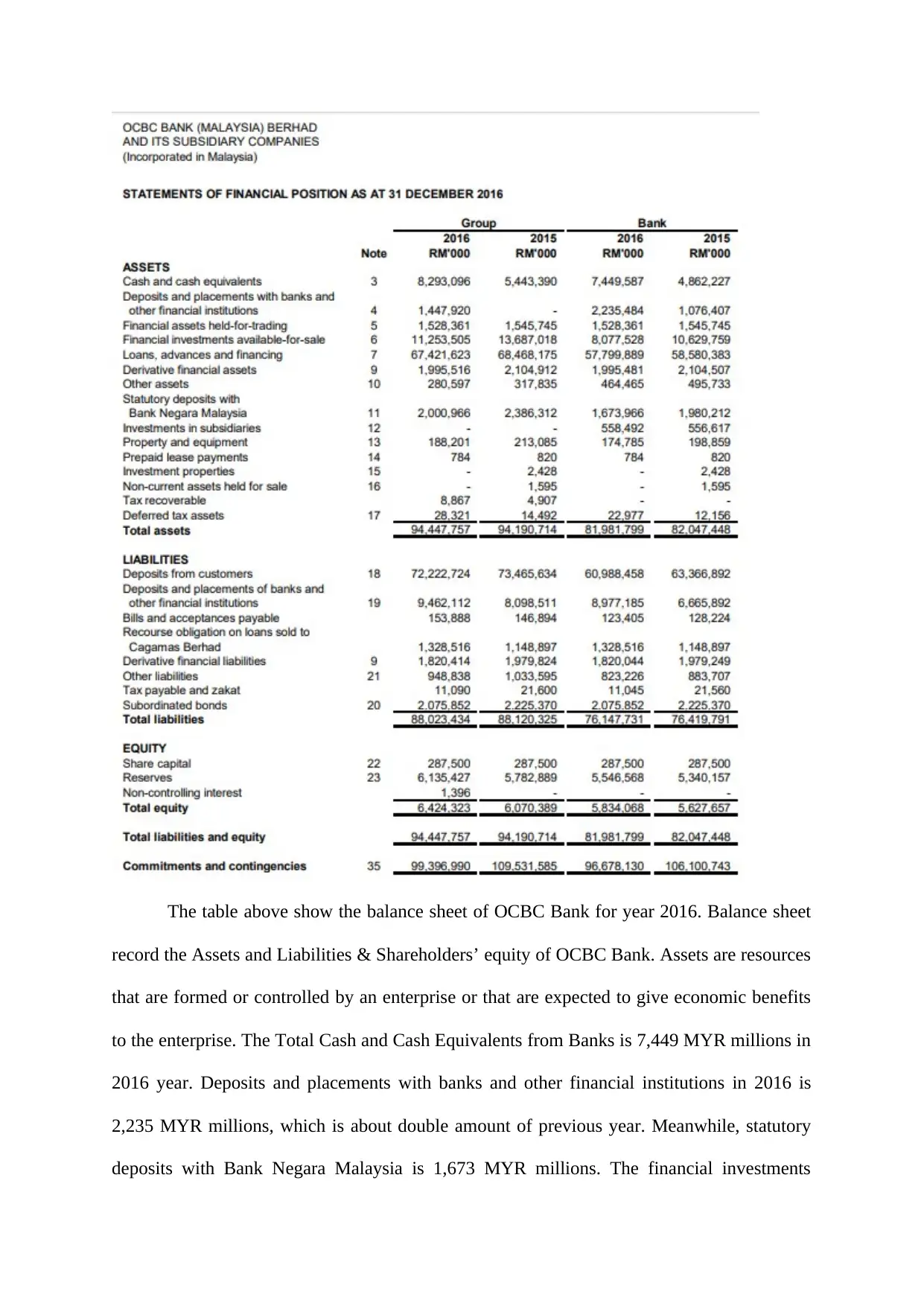
The table above show the balance sheet of OCBC Bank for year 2016. Balance sheet
record the Assets and Liabilities & Shareholders’ equity of OCBC Bank. Assets are resources
that are formed or controlled by an enterprise or that are expected to give economic benefits
to the enterprise. The Total Cash and Cash Equivalents from Banks is 7,449 MYR millions in
2016 year. Deposits and placements with banks and other financial institutions in 2016 is
2,235 MYR millions, which is about double amount of previous year. Meanwhile, statutory
deposits with Bank Negara Malaysia is 1,673 MYR millions. The financial investments
record the Assets and Liabilities & Shareholders’ equity of OCBC Bank. Assets are resources
that are formed or controlled by an enterprise or that are expected to give economic benefits
to the enterprise. The Total Cash and Cash Equivalents from Banks is 7,449 MYR millions in
2016 year. Deposits and placements with banks and other financial institutions in 2016 is
2,235 MYR millions, which is about double amount of previous year. Meanwhile, statutory
deposits with Bank Negara Malaysia is 1,673 MYR millions. The financial investments
Paraphrase This Document
Need a fresh take? Get an instant paraphrase of this document with our AI Paraphraser
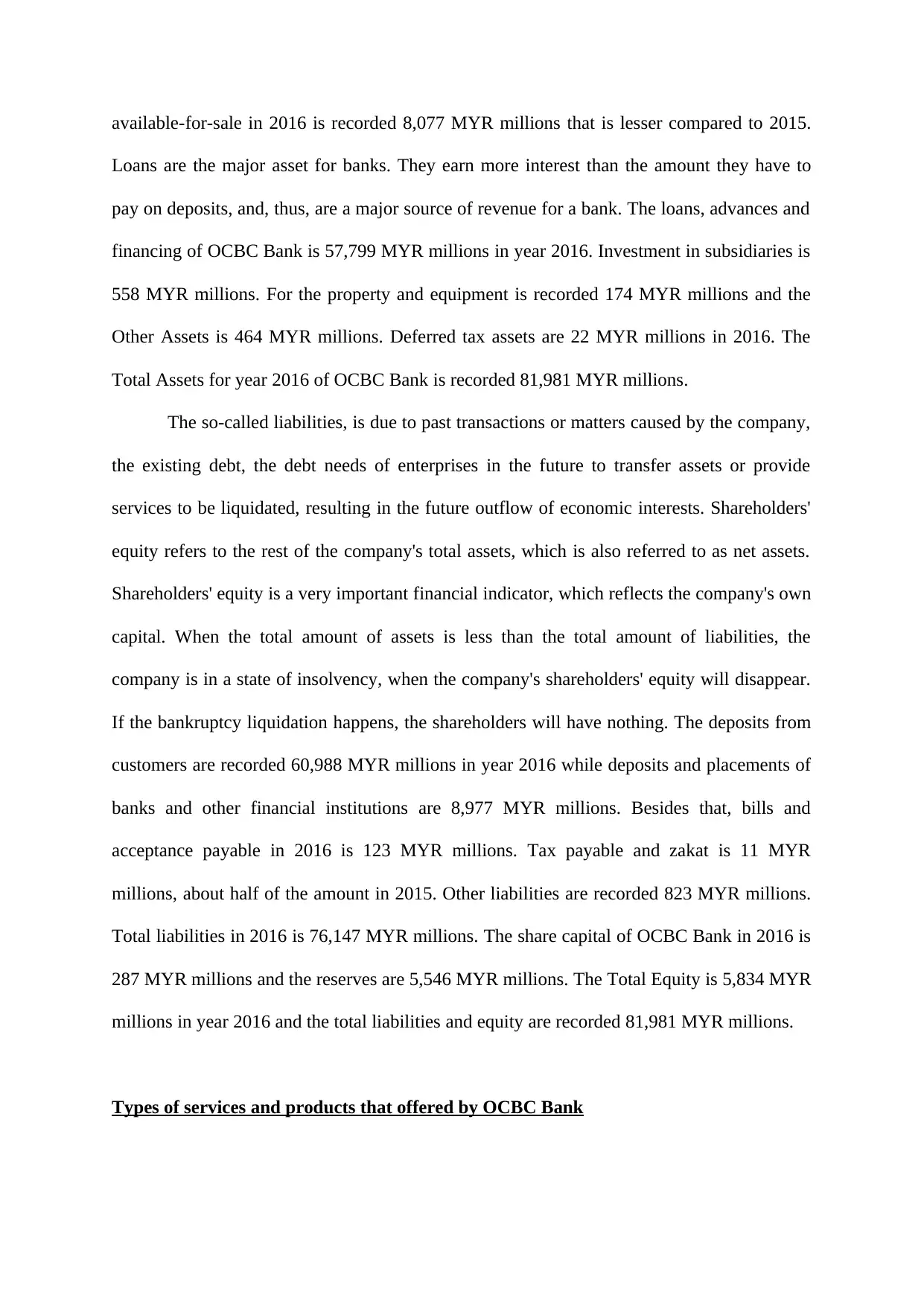
available-for-sale in 2016 is recorded 8,077 MYR millions that is lesser compared to 2015.
Loans are the major asset for banks. They earn more interest than the amount they have to
pay on deposits, and, thus, are a major source of revenue for a bank. The loans, advances and
financing of OCBC Bank is 57,799 MYR millions in year 2016. Investment in subsidiaries is
558 MYR millions. For the property and equipment is recorded 174 MYR millions and the
Other Assets is 464 MYR millions. Deferred tax assets are 22 MYR millions in 2016. The
Total Assets for year 2016 of OCBC Bank is recorded 81,981 MYR millions.
The so-called liabilities, is due to past transactions or matters caused by the company,
the existing debt, the debt needs of enterprises in the future to transfer assets or provide
services to be liquidated, resulting in the future outflow of economic interests. Shareholders'
equity refers to the rest of the company's total assets, which is also referred to as net assets.
Shareholders' equity is a very important financial indicator, which reflects the company's own
capital. When the total amount of assets is less than the total amount of liabilities, the
company is in a state of insolvency, when the company's shareholders' equity will disappear.
If the bankruptcy liquidation happens, the shareholders will have nothing. The deposits from
customers are recorded 60,988 MYR millions in year 2016 while deposits and placements of
banks and other financial institutions are 8,977 MYR millions. Besides that, bills and
acceptance payable in 2016 is 123 MYR millions. Tax payable and zakat is 11 MYR
millions, about half of the amount in 2015. Other liabilities are recorded 823 MYR millions.
Total liabilities in 2016 is 76,147 MYR millions. The share capital of OCBC Bank in 2016 is
287 MYR millions and the reserves are 5,546 MYR millions. The Total Equity is 5,834 MYR
millions in year 2016 and the total liabilities and equity are recorded 81,981 MYR millions.
Types of services and products that offered by OCBC Bank
Loans are the major asset for banks. They earn more interest than the amount they have to
pay on deposits, and, thus, are a major source of revenue for a bank. The loans, advances and
financing of OCBC Bank is 57,799 MYR millions in year 2016. Investment in subsidiaries is
558 MYR millions. For the property and equipment is recorded 174 MYR millions and the
Other Assets is 464 MYR millions. Deferred tax assets are 22 MYR millions in 2016. The
Total Assets for year 2016 of OCBC Bank is recorded 81,981 MYR millions.
The so-called liabilities, is due to past transactions or matters caused by the company,
the existing debt, the debt needs of enterprises in the future to transfer assets or provide
services to be liquidated, resulting in the future outflow of economic interests. Shareholders'
equity refers to the rest of the company's total assets, which is also referred to as net assets.
Shareholders' equity is a very important financial indicator, which reflects the company's own
capital. When the total amount of assets is less than the total amount of liabilities, the
company is in a state of insolvency, when the company's shareholders' equity will disappear.
If the bankruptcy liquidation happens, the shareholders will have nothing. The deposits from
customers are recorded 60,988 MYR millions in year 2016 while deposits and placements of
banks and other financial institutions are 8,977 MYR millions. Besides that, bills and
acceptance payable in 2016 is 123 MYR millions. Tax payable and zakat is 11 MYR
millions, about half of the amount in 2015. Other liabilities are recorded 823 MYR millions.
Total liabilities in 2016 is 76,147 MYR millions. The share capital of OCBC Bank in 2016 is
287 MYR millions and the reserves are 5,546 MYR millions. The Total Equity is 5,834 MYR
millions in year 2016 and the total liabilities and equity are recorded 81,981 MYR millions.
Types of services and products that offered by OCBC Bank
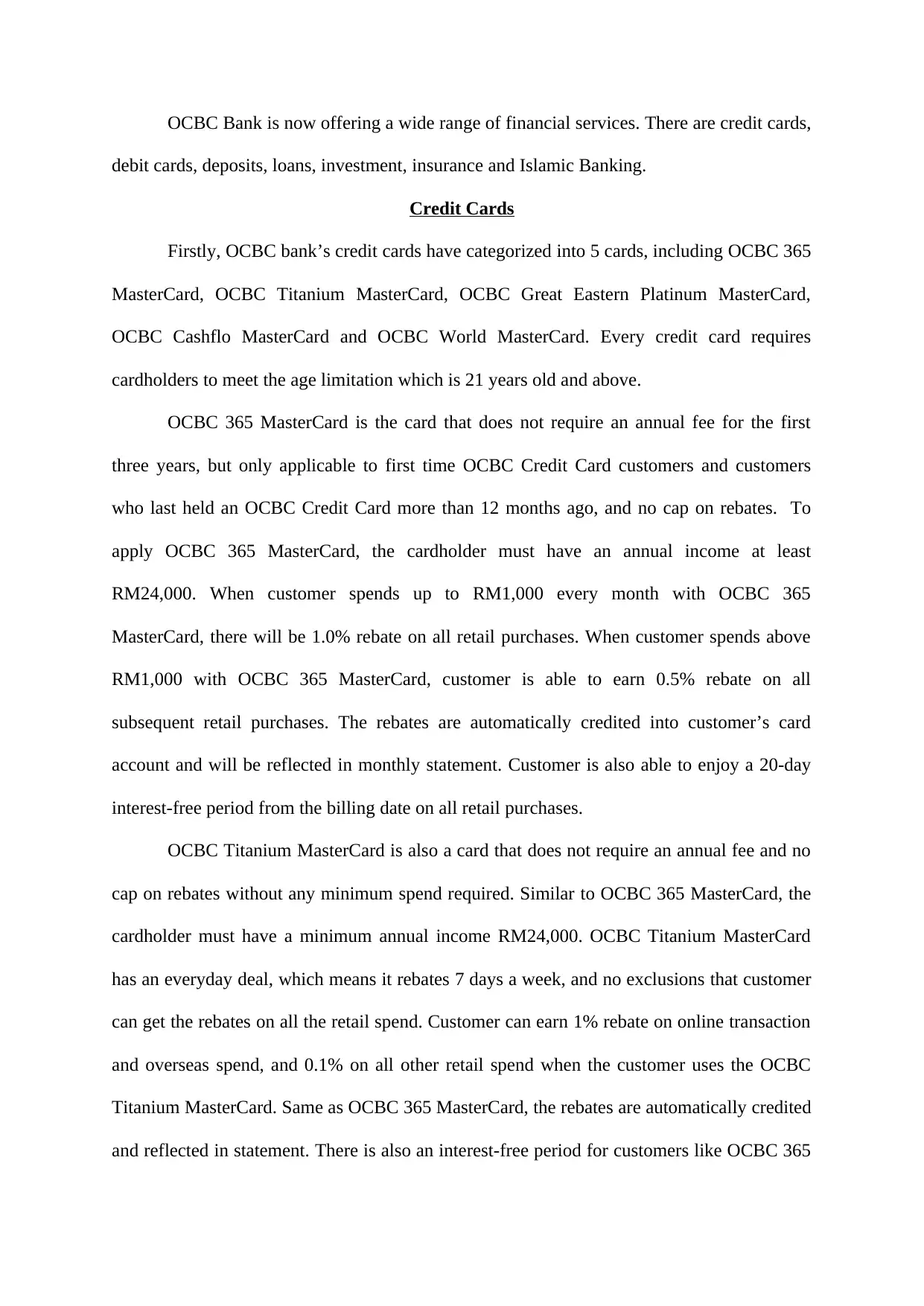
OCBC Bank is now offering a wide range of financial services. There are credit cards,
debit cards, deposits, loans, investment, insurance and Islamic Banking.
Credit Cards
Firstly, OCBC bank’s credit cards have categorized into 5 cards, including OCBC 365
MasterCard, OCBC Titanium MasterCard, OCBC Great Eastern Platinum MasterCard,
OCBC Cashflo MasterCard and OCBC World MasterCard. Every credit card requires
cardholders to meet the age limitation which is 21 years old and above.
OCBC 365 MasterCard is the card that does not require an annual fee for the first
three years, but only applicable to first time OCBC Credit Card customers and customers
who last held an OCBC Credit Card more than 12 months ago, and no cap on rebates. To
apply OCBC 365 MasterCard, the cardholder must have an annual income at least
RM24,000. When customer spends up to RM1,000 every month with OCBC 365
MasterCard, there will be 1.0% rebate on all retail purchases. When customer spends above
RM1,000 with OCBC 365 MasterCard, customer is able to earn 0.5% rebate on all
subsequent retail purchases. The rebates are automatically credited into customer’s card
account and will be reflected in monthly statement. Customer is also able to enjoy a 20-day
interest-free period from the billing date on all retail purchases.
OCBC Titanium MasterCard is also a card that does not require an annual fee and no
cap on rebates without any minimum spend required. Similar to OCBC 365 MasterCard, the
cardholder must have a minimum annual income RM24,000. OCBC Titanium MasterCard
has an everyday deal, which means it rebates 7 days a week, and no exclusions that customer
can get the rebates on all the retail spend. Customer can earn 1% rebate on online transaction
and overseas spend, and 0.1% on all other retail spend when the customer uses the OCBC
Titanium MasterCard. Same as OCBC 365 MasterCard, the rebates are automatically credited
and reflected in statement. There is also an interest-free period for customers like OCBC 365
debit cards, deposits, loans, investment, insurance and Islamic Banking.
Credit Cards
Firstly, OCBC bank’s credit cards have categorized into 5 cards, including OCBC 365
MasterCard, OCBC Titanium MasterCard, OCBC Great Eastern Platinum MasterCard,
OCBC Cashflo MasterCard and OCBC World MasterCard. Every credit card requires
cardholders to meet the age limitation which is 21 years old and above.
OCBC 365 MasterCard is the card that does not require an annual fee for the first
three years, but only applicable to first time OCBC Credit Card customers and customers
who last held an OCBC Credit Card more than 12 months ago, and no cap on rebates. To
apply OCBC 365 MasterCard, the cardholder must have an annual income at least
RM24,000. When customer spends up to RM1,000 every month with OCBC 365
MasterCard, there will be 1.0% rebate on all retail purchases. When customer spends above
RM1,000 with OCBC 365 MasterCard, customer is able to earn 0.5% rebate on all
subsequent retail purchases. The rebates are automatically credited into customer’s card
account and will be reflected in monthly statement. Customer is also able to enjoy a 20-day
interest-free period from the billing date on all retail purchases.
OCBC Titanium MasterCard is also a card that does not require an annual fee and no
cap on rebates without any minimum spend required. Similar to OCBC 365 MasterCard, the
cardholder must have a minimum annual income RM24,000. OCBC Titanium MasterCard
has an everyday deal, which means it rebates 7 days a week, and no exclusions that customer
can get the rebates on all the retail spend. Customer can earn 1% rebate on online transaction
and overseas spend, and 0.1% on all other retail spend when the customer uses the OCBC
Titanium MasterCard. Same as OCBC 365 MasterCard, the rebates are automatically credited
and reflected in statement. There is also an interest-free period for customers like OCBC 365
⊘ This is a preview!⊘
Do you want full access?
Subscribe today to unlock all pages.

Trusted by 1+ million students worldwide
1 out of 58
Your All-in-One AI-Powered Toolkit for Academic Success.
+13062052269
info@desklib.com
Available 24*7 on WhatsApp / Email
![[object Object]](/_next/static/media/star-bottom.7253800d.svg)
Unlock your academic potential
Copyright © 2020–2025 A2Z Services. All Rights Reserved. Developed and managed by ZUCOL.
